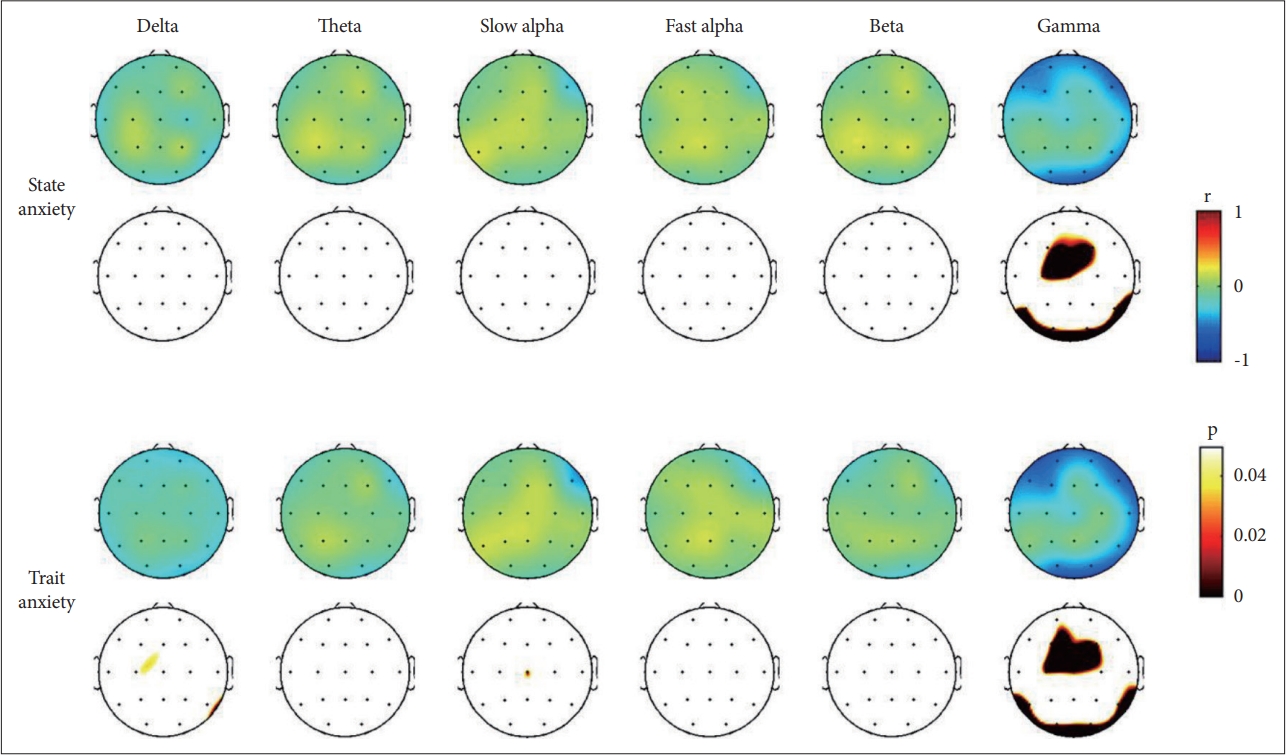1. American Psychiatric Association. Diagnostic and statistical manual of mental disorders (DSM-5-TR). 5th ed. Arlington: American Psychiatric Publishing; 2013.
3. Kozak MJ, Cuthbert BN. The NIMH research domain criteria initiative: background, issues, and pragmatics. Psychophysiology 2016;53:286-297.


5. Spielberger CD. State‐Trait anger expression inventory. In: Weiner IB, Craighead WE, editor. The Corsini encyclopedia of psychology, vol. 4. Hoboken: John Wiley & Sons, 2010, p. 1698-1699.
6. Baur V, Hänggi J, Langer N, Jäncke L. Resting-state functional and structural connectivity within an insula-amygdala route specifically index state and trait anxiety. Biol Psychiatry 2013;73:85-92.


10. McVoy M, Lytle S, Fulchiero E, Aebi ME, Adeleye O, Sajatovic M. A systematic review of quantitative EEG as a possible biomarker in child psychiatric disorders. Psychiatry Res 2019;279:331-344.


11. Coburn KL, Lauterbach EC, Boutros NN, Black KJ, Arciniegas DB, Coffey CE. The value of quantitative electroencephalography in clinical psychiatry: a report by the Committee on Research of the American Neuropsychiatric Association. J Neuropsychiatry Clin Neurosci 2006;18:460-500.


12. Chabot RJ, di Michele F, Prichep L. The role of quantitative electroencephalography in child and adolescent psychiatric disorders. Child Adolesc Psychiatr Clin N Am 2005;14:21-53.


13. Perera MPN, Bailey NW, Herring SE, Fitzgerald PB. Electrophysiology of obsessive compulsive disorder: a systematic review of the electroencephalographic literature. J Anxiety Disord 2019;62:1-14.


14. Carvalho MR, Velasques BB, Cagy M, Marques JB, Teixeira S, Nardi AE, et al. Electroencephalographic findings in panic disorder. Trends Psychiatry Psychother 2013;35:238-251.


15. Buchsbaum MS, Hazlett E, Sicotte N, Stein M, Wu J, Zetin M. Topographic EEG changes with benzodiazepine administration in generalized anxiety disorder. Biol Psychiatry 1985;20:832-842.


16. Siciliani O, Schiavon M, Tansella M. Anxiety and EEG alpha activity in neurotic patients. Acta Psychiatr Scand 1975;52:116-131.


17. Tas C, Erensoy H, İbadi Y, Brown E, Tarhan N. QEEG related changes following the treatment of anxiety disorders: case series. J Neurobehav Sci 2014;1:9-13.

19. Silverman JS, Loychik SG. Brain-mapping abnormalities in a family with three obsessive compulsive children. J Neuropsychiatry Clin Neurosci 1990;2:319-322.


20. Nitschke JB, Heller W. Distinguishing neural substrates of heterogeneity among anxiety disorders. Int Rev Neurobiol 2005;67:1-42.


22. Beck AT, Ward CH, Mendelson M, Mock J, Erbaugh J. An inventory for measuring depression. Arch Gen Psychiatry 1961;4:561-571.


23. Sung HM, Kim JB, Park YN, Bai DS, Lee SH, Ahn HN. A study on the reliability and the validity of Korean version of the Beck Depression Inventory-II (BDI-II). J Korean Soc Biol Ther Psychiatry 2008;14:201-212.
24. Kim JT, Shin DK. A study based on the standardization of the STAI for Korea. New Med J 1978;21:69-75.
25. Hahn DW, Lee CH, Chon KK. Korean adaptation of Spielberger’s. STAI (K-STAI). Korean J Health Psychol 1996;1:1-14.
26. Kim J, Lee Y, Han D, Min K, Kim D, Lee C. The utility of quantitative electroencephalography and integrated visual and auditory continuous performance test as auxiliary tools for the attention deficit hyperactivity disorder diagnosis. Clin Neurophysiol 2015;126:532-540.


28. Kim JW, Lee YS, Han DH, Min KJ, Lee J, Lee K. Diagnostic utility of quantitative EEG in un-medicated schizophrenia. Neurosci Lett 2015;589:126-131.


29. Delorme A, Makeig S. EEGLAB: an open source toolbox for analysis of single-trial EEG dynamics including independent component analysis. J Neurosci Methods 2004;134:9-21.


30. Jung TP, Makeig S, Humphries C, Lee TW, McKeown MJ, Iragui V, et al. Removing electroencephalographic artifacts by blind source separation. Psychophysiology 2000;37:163-178.


31. Jung TP, Makeig S, Westerfield M, Townsend J, Courchesne E, Sejnowski TJ. Removal of eye activity artifacts from visual event-related potentials in normal and clinical subjects. Clin Neurophysiol 2000;111:1745-1758.


34. Herrmann CS, Fründ I, Lenz D. Human gamma-band activity: a review on cognitive and behavioral correlates and network models. Neurosci Biobehav Rev 2010;34:981-992.


35. Tallon-Baudry C, Bertrand O. Oscillatory gamma activity in humans and its role in object representation. Trends Cogn Sci 1999;3:151-162.


36. Jensen O, Kaiser J, Lachaux JP. Human gamma-frequency oscillations associated with attention and memory. Trends Neurosci 2007;30:317-324.


38. Keil A, Müller MM, Gruber T, Wienbruch C, Stolarova M, Elbert T. Effects of emotional arousal in the cerebral hemispheres: a study of oscillatory brain activity and event-related potentials. Clin Neurophysiol 2001;112:2057-2068.


40. Liu J, Li J, Peng W, Feng M, Luo Y. EEG correlates of math anxiety during arithmetic problem solving: implication for attention deficits. Neurosci Lett 2019;703:191-197.


41. Schneider TR, Hipp JF, Domnick C, Carl C, Büchel C, Engel AK. Modulation of neuronal oscillatory activity in the beta- and gammaband is associated with current individual anxiety levels. Neuroimage 2018;178:423-434.


42. Miskovic V, Ashbaugh AR, Santesso DL, McCabe RE, Antony MM, Schmidt LA. Frontal brain oscillations and social anxiety: a cross-frequency spectral analysis during baseline and speech anticipation. Biol Psychol 2010;83:125-132.


44. McNally R. Abnormalities in anxiety implications for cognitive neuroscience. Cogn Emot 1998;12:479-495.

45. Aftanas LI, Pavlov SV, Reva NV, Varlamov AA. Trait anxiety impact on the EEG theta band power changes during appraisal of threatening and pleasant visual stimuli. Int J Psychophysiol 2003;50:205-212.


46. Derryberry D, Reed MA. Anxiety-related attentional biases and their regulation by attentional control. J Abnorm Psychol 2002;111:225-236.


47. Suárez-Pellicioni M, Núñez-Peña MI, Colomé A. Mathematical anxiety effects on simple arithmetic processing efficiency: an event-related potential study. Biol Psychol 2013;94:517-526.


48. Klados MA, Paraskevopoulos E, Pandria N, Bamidis PD. The impact of math anxiety on working memory: a cortical activations and cortical functional connectivity EEG study. IEEE Access 2019;7:15027-15039.

49. Roh SC, Park EJ, Shim M, Lee SH. EEG beta and low gamma power correlates with inattention in patients with major depressive disorder. J Affect Disord 2016;204:124-130.


50. Knyazev GG, Savostyanov AN, Levin EA. Alpha oscillations as a correlate of trait anxiety. Int J Psychophysiol 2004;53:147-160.


51. Knott VJ, Bakish D, Lusk S, Barkely J, Perugini M. Quantitative EEG correlates of panic disorder. Psychiatry Res 1996;68:31-39.


52. Sachs G, Anderer P, Dantendorfer K, Saletu B. EEG mapping in patients with social phobia. Psychiatry Res 2004;131:237-247.












